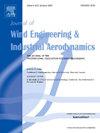Field study on pressure fluctuations and comfort analysis when high-speed train passes through large-slope tunnels and tunnel groups
IF 4.9
2区 工程技术
Q1 ENGINEERING, CIVIL
Journal of Wind Engineering and Industrial Aerodynamics
Pub Date : 2025-04-07
DOI:10.1016/j.jweia.2025.106100
引用次数: 0
Abstract
High-speed trains passing through 25 ‰ sloped tunnels and tunnel groups experience complex and varying pressure environments within the tunnel. When these external pressure fluctuations are transmitted into the carriages, they alter the internal pressure environment and affect the passenger comfort. In this paper, field measurements have been used to study the influences of tunnel lengths, slopes and tunnel groups on the interior and exterior pressure variation of the train and pressure comfort. The key findings reveal that the atmospheric pressure in single-slope tunnels changes linearly with tunnel altitude at a rate of 10.21 Pa/m. External negative pressures in the uphill tunnels and external positive pressures in the downhill tunnels demonstrate a linear and positive relationship with tunnel lengths. Tunnel slopes and tunnel groups worsen the pressure comfort environments. Additionally, during actual operation on a 25 ‰ uphill railway line, delayed valve closure upon tunnel entry and premature valve opening within tunnels significantly degrade the pressure comfort environment inside the train, resulting in ear discomfort for passengers. Hence, optimizing the logic for opening and closing pressure protection valves based on line characteristics is essential. These findings can provide valuable references for optimizing operating environments and pressure comfort in high-altitude, large-slope and multiple-tunnels lines.
高速列车通过大坡度隧道及隧道群时的压力波动及舒适性分析
高速列车通过25‰坡度隧道和隧道组时,在隧道内经历复杂多变的压力环境。当这些外部压力波动传递到车厢内时,就会改变车厢内的压力环境,影响乘客的舒适度。本文通过现场实测,研究了隧道长度、坡度和隧道组对列车内外压力变化及压力舒适性的影响。结果表明,单坡隧道内大气压力随隧道海拔呈线性变化,变化速率为10.21 Pa/m;上坡隧道外部负压力和下坡隧道外部正压力与隧道长度呈线性正相关。隧道边坡和隧道群使压力舒适环境恶化。另外,在25‰上坡铁路实际运行过程中,隧道入口阀门关闭延迟、隧道内阀门开启过早等问题严重降低了车厢内压力舒适环境,造成乘客耳部不适。因此,基于线路特性优化开启和关闭压力保护阀的逻辑是至关重要的。研究结果可为高海拔、大坡度、多隧道线路的运行环境和压力舒适性优化提供有价值的参考。
本文章由计算机程序翻译,如有差异,请以英文原文为准。
求助全文
约1分钟内获得全文
求助全文
来源期刊
CiteScore
8.90
自引率
22.90%
发文量
306
审稿时长
4.4 months
期刊介绍:
The objective of the journal is to provide a means for the publication and interchange of information, on an international basis, on all those aspects of wind engineering that are included in the activities of the International Association for Wind Engineering http://www.iawe.org/. These are: social and economic impact of wind effects; wind characteristics and structure, local wind environments, wind loads and structural response, diffusion, pollutant dispersion and matter transport, wind effects on building heat loss and ventilation, wind effects on transport systems, aerodynamic aspects of wind energy generation, and codification of wind effects.
Papers on these subjects describing full-scale measurements, wind-tunnel simulation studies, computational or theoretical methods are published, as well as papers dealing with the development of techniques and apparatus for wind engineering experiments.

 求助内容:
求助内容: 应助结果提醒方式:
应助结果提醒方式:


